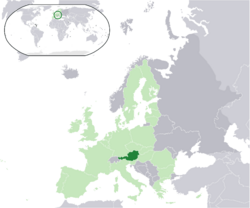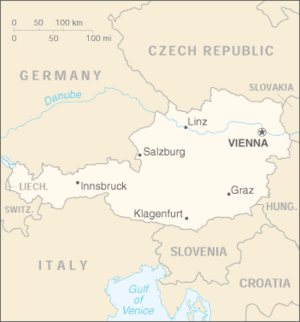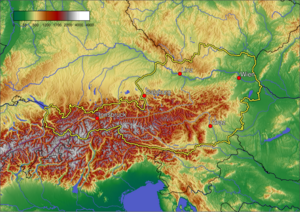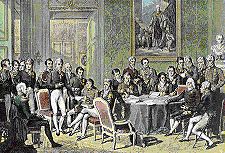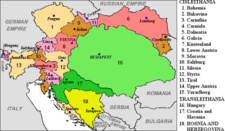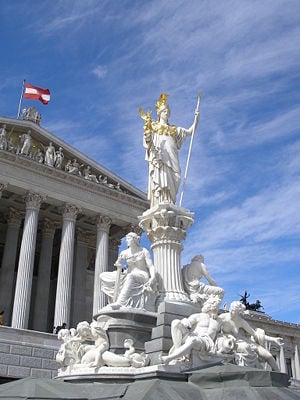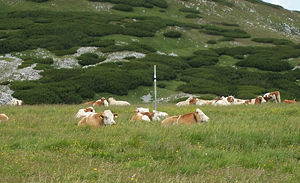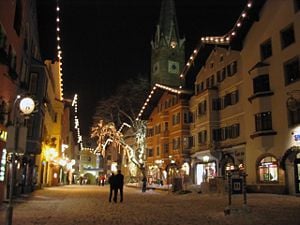Austria
| Republik Österreich Republic of Austria | |||||
| |||||
| Anthem: Land der Berge, Land am Strome (German) Land of Mountains, Land on the River | |||||
|
Location of Austria (dark green)
– on the European continent (light green dark grey) – in the European Union (light green) | |||||
| Capital | Vienna 48°12′N 16°21′E | ||||
|---|---|---|---|---|---|
| Largest city | capital | ||||
| Official languages | German locally also Hungarian, Slovenian and Croatian | ||||
| Government | Federal republic | ||||
| - President | Heinz Fischer | ||||
| - Chancellor | Alfred Gusenbauer | ||||
| Independence | |||||
| - Austrian State Treaty in force | July 27 1955 | ||||
| - Declaration of Neutrality | October 26 1955 (before: Austrian Empire: 1804, First Austrian Republic: 1918) | ||||
| Accession to EU | January 1, 1995 | ||||
| Area | |||||
| - Total | 83,872 km² (115th) 32383 sq mi | ||||
| - Water (%) | 1.7 | ||||
| Population | |||||
| - 2007 estimate | 8,316,487 | ||||
| - 2001 census | 8,032,926 | ||||
| - Density | 99/km² 257/sq mi | ||||
| GDP (PPP) | 2006 estimate | ||||
| - Total | $279.5 billion | ||||
| - Per capita | $36,000 | ||||
| GDP (nominal) | 2005 estimate | ||||
| - Total | $307.07 billion | ||||
| - Per capita | $37,117 | ||||
| HDI (2004) | |||||
| Currency | euro (€) ² (EUR)
| ||||
| Time zone | CET (UTC+1) | ||||
| - Summer (DST) | CEST (UTC+2) | ||||
| Internet TLD | .at ³ | ||||
| Calling code | +43 | ||||
Austria (German: Österreich) (Österreich ▶), officially the Republic of Austria (German: Republik Österreich), is a small, predominantly mountainous country located in Central Europe, approximately between Germany, Italy and Hungary.
The origins of modern Austria date back to the ninth century, when the countryside of upper and lower Austria became increasingly populated.
Austria is a parliamentary representative democracy consisting of nine federal states and is one of six European countries that have declared permanent neutrality and one of the few countries that includes the concept of everlasting neutrality in their constitution. Austria has been a member of the United Nations since 1955 and joined the European Union in 1995.
Geography
The German name Österreich can be translated into English as the "eastern realm", which is derived from the Old German Ostarrîchi. The name "Ostarrichi" is first documented in an official document from 996. Since then this word has developed into the German word Österreich. The name was Latinized as "Austria".
The landlocked country shares national borders with Switzerland and the tiny principality of Liechtenstein to the west, Germany and the Czech Republic and Slovakia to the north, Hungary to the east, and Slovenia and Italy to the south. It has a total area of 32,383 square miles (83,859 square kilometers), about twice the size of Switzerland and slightly smaller than the state of Maine.
Austria may be divided into three unequal geographical areas. The largest part of Austria (62 percent) is occupied by the relatively young mountains of the Alps, but in the east, these give way to a part of the Pannonian plain, and north of the River Danube lies the Böhmerwald, an older, but lower, granite mountain range.
The highest point is Grossglockner at 12,460 feet (3798 meters).
The greater part of Austria lies in the cool/temperate climate zone in which humid westerly winds predominate. The wetter western regions have an Atlantic climate with a yearly rainfall of about 40 inches (1000 millimetres), while the eastern regions have a drier, more continental type of climate, and less precipitation.
With over half of the country dominated by the Alps the alpine climate is the predominant one. In the East, in the Pannonian Plain and along the Danube valley, the climate shows continental features with less rain than the alpine areas. Although Austria is cold in the winter, in the summer temperatures can be relatively warm reaching 68°F -95°F (20°C-35°C).
Northern Austria is the location of the main watershed between the Black Sea and the North Sea. Most Austrian territory drains to the Danube River. Austria has numerous lakes, many a legacy of glacial erosion. The largest lakes are Lake Constance (Bodensee) in the west and the marshy Neusiedler Lake (Neusiedlersee) to the east.
Natural resources include oil, coal, lignite, timber, iron ore, copper, zinc, antimony, magnesite, tungsten, graphite, salt, and hydropower.
Austria has 44 percent of its area under forests. Deciduous beech, birch, and oak and conifers (fir) cover the mountains up to about 4000 feet (1200 meters), above which fir predominates and then gives way to larch and stone pine. Wildlife include some chamois, deer, hare, fox, badger, marten, Alpine chough, grouse, marmot, partridge, and pheasant. Birds include purple heron, spoonbill, and avocet. The ibex, once threatened, has begun breeding again.
Natural hazards include landslides, avalanches, and earthquakes. Environmental issues include some forest degradation caused by air and soil pollution, soil pollution resulting from the use of agricultural chemicals, air pollution resulting from emissions by coal- and oil-fired power stations and industrial plants and from trucks transiting Austria between northern and southern Europe.
Vienna is Austria's primary city, and had a population of about 1.7 million (2.3 million within the metropolitan area) in 2007. It is by far the largest city in Austria as well as its cultural, economic and political centre.
History
Prehistory and the Middle Ages
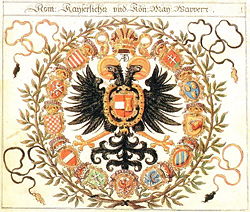
Settled in prehistoric times, the central European land that is now Austria was occupied in pre-Roman times by various Celtic tribes. The Celtic kingdom of Noricum was claimed by the Roman Empire and made a province. After the fall of the Roman Empire, of which most of Austria was part (all parts south of the Danube), the area was invaded by Bavarians, Slavs and Avars. Charlemagne conquered the area in 788 and encouraged colonization and Christianity. As part of Eastern Francia, the core areas that now encompass Austria were bequeathed to the house of Babenberg. The area was known as the marchia Orientalis and was given to Leopold of Babenberg in 976.
The first record showing the name Austria is from 996 where it is written as Ostarrîchi, referring to the territory of the Babenberg March. The term Ostmark is not historically ascertained and appears to be a translation of marchia orientalis that came up only much later.
The following centuries were characterized first by the settlement of the country. In 1156 the Privilegium Minus elevated Austria to the status of a duchy. In 1192, the Babenbergs also acquired the Duchy of Styria.
With the death of Frederick II in 1246, the line of the Babenbergers went extinct. Otakar II of Bohemia effectively controlled the duchies of Austria, Styria and Carinthia after that. His reign came to an end with his defeat at Dürnkrut at the hand of Rudolf I of Germany in 1278. Thereafter, until World War I, Austria's history was largely that of its ruling dynasty, the Habsburgs.
Rise of The Habsburgs
In the fourteenth and fifteenth centuries, the Habsburgs began to accumulate other provinces in the vicinity of the Duchy of Austria. In 1438, Duke Albert V of Austria was chosen as the successor to his father-in-law, Emperor Sigismund. Although Albert himself only reigned for a year, from then on, every emperor of the Holy Roman Empire was a Habsburg, with only one exception.
The Habsburgs began also to accumulate lands far from the Hereditary Lands. In 1477, the Archduke Maximilian, only son of Emperor Frederick III, married the heiress of Burgundy, thus acquiring most of the Low Countries for the family. His son Philip the Fair married the heiress of Castile and Aragon, and thus acquired Spain and its Italian, African, and New World appendages for the Habsburgs.
In 1526, following the Battle of Mohács, Austrian rulers expanded their territories, bringing Bohemia and the part of Hungary not occupied by the Ottomans under their rule. Ottoman expansion into Hungary led to frequent conflicts between the two powers, particularly evident in the so-called Long War of 1593 to 1606.
Austria as a European Power
Template:Cleanup-section
The long reign of Leopold I (1657–1705) saw the culmination of the Austrian conflict with the Turks. Following the successful defense of Vienna in 1683, a series of campaigns resulted in the return of all of Hungary to Austrian control by the Treaty of Carlowitz in 1699. The later part of the reign of Emperor Charles VI (1711–1740) saw Austria relinquish many of these fairly impressive gains, largely due to Charles's apprehensions at the imminent extinction of the House of Habsburg. Charles was willing to offer concrete advantages in territory and authority in exchange for other powers' worthless recognitions of the Pragmatic Sanction that made his daughter Maria Theresa his heir. With the rise of Prussia the Austrian–Prussian dualism began in Germany.
Austria became engaged in the war with Revolutionary France, which lasted until 1797 and at the beginning proved unsuccessful for Austria. Defeats against Napoleon meant the end of the old Holy Roman Empire in 1806. Just two years before the abolition of the Holy Roman Empire in 1806, in 1804 the Empire of Austria was founded, which was transformed in 1867 into the dual-monarchy Austria-Hungary. However, in 1814 Austria was part of the Allied forces invading France and conquering it. Following the Napoleonic wars Austria emerged from the Congress of Vienna in 1815 as one of three of the continent's dominant powers (together with Russia and Prussia). In 1815 the German Confederation, (German) Deutscher Bund was founded under the presidency of Austria. Austria and Prussia were the leading powers of the German Confederation. Its central institution was the Bundesversammlung in Frankfurt. Because of unsolved social, political and national conflicts some of the German inhabitants took part in the 1848 revolution to create a unified Germany. The Frankfurt Parliament in the St. Paul's Church elected the arch duke Johann of Habsburg as a Reichsverweser, an administrator of the German Empire. For a new German empire would have been possible three options: a Greater Germany Großdeutschland with the German-speaking territories of the Habsburg Empire, a Greater Austrian solution, Großösterreich, the German Confederation with the whole Habsurgian territories, and a smaller German solution, Kleindeutsche the German Confederation without Austria at all. As Austria was not willing to relinquish its German-speaking territories to what would become the German Empire of 1848 the parliament offered the crown the Prussian King Friedrich Wilhelm IV. Austria grew out of Germany, Prussia grew in. In 1864 Austria and Prussia fought together against Denmark, to free the independent dutchies Schleswig and Holstein. Austria and Prussia could not agree on a solution to the administration of Schleswig and Holstein, which led to the Austro-Prussian War of 1866. Austria, that fought together with most of the German states was defeated by Prussia in the battle of Königgrätz in Bohemia. Austria had to leave the German Confederation and was subsequently no longer permitted to take part in German politics.
The Austro-Hungarian Compromise of 1867 provided for a dual sovereignty, the empire of Austria and the kingdom of Hungary, under Franz Joseph I, who ruled until his death on 21 November 1916. The German-Hungarian rule of this diverse empire, which included, various Slavic groups such as Poles, Ukrainians, Czechs, Slovaks, Slovenes, Serbs and Croats, as well as large Italian and Romanian communities. As a result, running Austria-Hungary became increasingly difficult in an age of emerging nationalist movements.
World War I and its aftermath
The assassination of Archduke Franz Ferdinand in Sarajevo in 1914 by Gavrilo Princip (a member of the Serbian nationalist group the Black Hand) was the proximate cause of World War I, which led to the downfall and the end of the Austro-Hungarian Empire. War left the country in political chaos and economic ruin, the Central Powers (being Austria-Hungary, Bulgaria, Germany and Turkey) having been defeated in 1918. The Empire was broken up - Austria, with most of the German-speaking parts became a republic (see Treaty of Saint-Germain) and all of what had been subordinated states became independent countries.
Between 1918 and 1919, it was officially known as the Republic of German Austria (Republik Deutschösterreich). After the Entente powers forbade German Austria to unite with Germany, they also forbade the name, it was thus changed to the Republic of Austria. The monarchy was dissolved in 1919 and a parliamentary democracy was set up by the constitution of 10 November 1920.
In the autumn of 1922, Austria was granted an international loan supervised by the League of Nations. The purpose of the loan was to avert bankruptcy, stabilize the currency, and improve the general economic condition. With the granting of the loan, Austria passed from an independent state to the control exercised by the League of Nations. At the time, the real ruler of Austria became the League, through its commissioner in Vienna. The commissioner was a Dutchman not formally part of the Austrian government. Austria had fallen under an international receivership, which had not been seen openly since Lord Croner became the financial advisor to the bankrupt Khedivial Government of Egypt a little less than half a century earlier.
Austrofascism and the Third Reich
The First Austrian Republic, lasted until 1933 when Chancellor Engelbert Dollfuß shut down parliament and established an autocratic regime oriented towards Italian fascism, (Austrofascism) to check the power of Nazis advocating union with Germany. The two big parties of this time —the Social Democrats and the Conservatives— had paramilitary armies, which fought each other. The "Heimwehr" (later integrated into the "Vaterländische Front"), the paramilitary arm of the Conservative party supported Dollfuß' s Fascist regime; the "Republikanischer Schutzbund", was the military arm of the Social Democrats which was outlawed in 1933 but still existed underground - civil war was to break out.
After the Austrian Civil War in February 1934, several members of the Schutzbund were executed, the Social Democratic party was outlawed and many of its members were imprisoned or emigrated. In May of that year the Fascists introduced a new constitution ("Maiverfassung") which cemented Dollfuß's power but on 25 July he was assassinated in a Nazi coup attempt.
His successor Kurt Schuschnigg, struggled to keep Austria independent but on 12 March 1938 German troops occupied the country and Hitler, himself a native of Austria who had lost Austrian citizenship in 1925, proclaimed its Anschluss with Germany, annexing it to the Third Reich. Austria thus ceased to exist as an independent country; the Nazis called it Ostmark until 1942 when it was renamed Alpen-Donau-Reichsgaue.
Just before the collapse of the Third Reich, the defeat of Germany and the end of the war, Karl Renner, astutely set up a Provisional Government in Vienna in April 1945 with the tacit approval of the Soviet forces and declared Austria's secession from the Third Reich.
After the defeat of Germany, Allied Occupation
Much like Germany, Austria, too, was divided into a British, a French, a Soviet and an American Zone and governed by the Allied Commission for Austria. Largely owing to Karl Renner's action on April 27th in setting up a Provisional Government, however, there was a subtle difference in the treatment of Austria by the Allies. The Austrian Government was recognized and tolerated by the Four Powers. Austria, in general, was treated like it had been originally invaded by Germany and liberated by the Allies.
Although the Eastern part of Austria, including the greater Vienna area, lay in the Soviet Zone, the capital itself was equally divided into four occupational zones. Outside of Vienna, however, travel across zone borders, in particular leaving or entering the Soviet zone, was difficult and time-consuming if possible at all. During the time of the Berlin Air Lift, Soviet military pressure was increased further, but could be successfully overcome by skillful military, political and diplomatic influence on the part of the other Allies.
On 15 May 1955 Austria regained full independence by concluding the Austrian State Treaty with the Four Occupying Powers. On 26 October 1955 Austria was declared "permanently neutral" by act of Parliament, which it remains to this day.
Recent history
The political system of the Second Republic came to be characterized by the system of Proporz, meaning that most posts of some political importance were split evenly between members of the Social Democrats (Labour Party) and the People's Party (Conservatives).
Interest group representations with mandatory membership (e.g. for workers, businesspeople, farmers etc.) grew to considerable importance and were usually consulted in the legislative process, so that hardly any legislation was passed that did not reflect widespread consensus. The Proporz and consensus systems largely held even during the years between 1966 and 1983, when there were non-coalition governments, but can now be called history.
Austria nowadays has five major political parties: The SPÖ (Labour Party), the ÖVP (Conservatives), the "Greens" (Environmental, social-liberal) and FPÖ/BZÖ (both right-wing, nationalist). SPÖ and ÖVP share about 75% of the parliamentary mandates, while the remaining 25% are divided between the other three parties.
Austria became a member of the European Union in 1995 and retained its constitutional neutrality, like some other EU members, such as Sweden. The major parties SPÖ and ÖVP have contrary opinions about the future status of Austria's military neutrality: While the SPÖ pleads for a neutral role in the EU (together with other neutral EU members like Sweden), the ÖVP argues for stronger integration into the EU's security policy; even a future NATO is not ruled out by some ÖVP politicians. Since the "permanant neutrality" forms part of the Austrian constitution, a two-thirds majority in the Austrian parliament would be needed.
Government and politics
Austria's constitution characterizes the republic as a federation consisting of nine autonomous federal states. Both the federation and all its states have written constitutions defining them to be republican entities governed according to the principles of representative democracy. Austria's government structure is surprisingly similar to that of incomparably larger federal republics such as Germany or the United States. A convention, called the Österreich–Konvent was convened in 2003 to reform the constitution, but has failed to produce a proposal that would receive the two thirds of votes in the Nationalrat necessary for constitutional amendments and/or reform.
Constitutional structure
The chief of state is the president, who is elected by direct popular vote for a six-year term, and is eligible for a second term. The head of government is the chancellor, who is formally chosen by the president but determined by the coalition parties forming a parliamentary majority. The vice chancellor chosen by the president on the advice of the chancellor.
The bicameral Federal Assembly, or Bundesversammlung, consists of Federal Council or Bundesrat, which has 62 members who are chosen by state parliaments with each state receiving three to 12 members, according to its population, to serve a five- or six-year term, and the National Council, or Nationalrat, which has 183 members elected by direct popular vote to serve four-year terms, by proportional representation. Seats in the Nationalrat are awarded to political parties that have obtained at least a four percent threshold of the general vote, or alternatively, have won a direct seat, or Direktmandat, in one of the 43 regional election districts. This "Four Percent Hurdle" prevents a large splintering of the political landscape in the Nationalrat. Suffrage is universal to those aged 18 years and over.
In the 2006 Nationalrat election, the Social Democratic Party of Austria, backed by blue- and white-collar workers, and is strong in urban and industrialized areas, took 35.34 percent of the vote. The Austrian People's Party, which advocates conservative financial policies and privatization of much of Austria's nationalized industry and finds support from farmers, large and small business owners, and lay Catholic groups, took 34.33 percent. The Greens took 11.05 percent, the Freedom Party of Austria the Greens took 11.04 percent, and the Alliance for the Future of Austria took 4.11 percent.
The judiciary comprises the Supreme Judicial Court, the Administrative Court, and Constitutional Court. The legal system is based on civil law system originating from Roman law. There is judicial review of legislative acts by the Constitutional Court, and there are separate administrative and civil/penal supreme courts. Austria accepts compulsory International Court of Justice jurisdiction.
Recent political developments
In February 2000 the conservative People's Party formed a coalition with the controversial nationalistic Freedom Party, headed by Jörg Haider. The (at that time) 14 other member states of the European Union - but not the EU itself - condemned Austria's new coalition, froze diplomatic contacts, which were commonly referred to "sanctions", although they were more or less diplomatic unfriendliness. Given the controversy, Haider chose not to join the government, but he continued to wield influence from the sidelines.
In September 2002, the coalition between the People's Party and the Freedom Party dissolved after a shake-up in the Freedom Party. In November 2002, the People's Party made large gains in general elections. After failed coalition talks with other parties, the People's Party again formed a government with the Freedom Party in February 2003.
After general elections held in October 2006, the Social Democrats emerged as the largest party, whereas the People's Party lost about 8% in votes. Political realities prohibited any of the two major parties from forming a coalition with smaller parties. In January 2007 the People's Party and Social Democrats formed a Grand Coalition with the social democrat Alfred Gusenbauer as Chancellor.
Administrative divisions
A federal republic, Austria is divided into nine states (German: 'Bundesländer'). These states are then divided into districts (Bezirke) and cities (Statutarstädte). Districts are subdivided into municipalities (Gemeinden). Cities have the competencies otherwise granted to both districts and municipalities. The states are not mere administrative divisions but have some distinct legislative authority separate from the federal government.
Perpetual neutrality
The 1955 Austrian State Treaty ended the occupation of Austria following World War II and recognized Austria as an independent and sovereign state. In October 1955, the Federal Assembly passed a constitutional law in which "Austria declares of her own free will her perpetual neutrality." The second section of this law stated that "in all future times Austria will not join any military alliances and will not permit the establishment of any foreign military bases on her territory." Since then, Austria has shaped its foreign policy on the basis of neutrality. Austria began to reassess its definition of neutrality following the fall of the Soviet Union, granting overflight rights for the UN-sanctioned action against Iraq in 1991, and, since 1995, contemplating participation in the EU's evolving security structure. Also in 1995, it joined the Partnership for Peace and subsequently participated in peacekeeping missions in Bosnia. Austria attaches great importance to participation in the Organisation for Economic Co-operation and Development and other international economic organizations, and it has played an active role in the Organization for Security and Cooperation in Europe (OSCE).
Energy politics
In 1972, the country began construction of a nuclear-powered electricity-generation station at Zwentendorf on the River Danube, following a unanimous vote in parliament. However, in 1978, a referendum voted approximately 50.5 percent against nuclear power, 49.5 percent for, and parliament subsequently unanimously passed a law forbidding the use of nuclear power to generate electricity. Austria produces more than half of its electricity by hydropower. Together with other renewable energy sources such as wind, solar and biomass powerplants, the electricity supply from renewable energy amounts to nearly 80 percent of total use in Austria. The rest is produced by gas and oil powerplants.
Military
The main branches of the Austrian Armed Forces ("Bundesheer") are Joint Forces (Streitkräfteführungskommando, SKFüKdo) which consist of Land Forces (Landstreitkräfte), Air Forces (Luftstreitkräfte), International Missions (Internationale Einsätze), and Special Forces (Spezialeinsatzkräfte); next to Mission Support (Kommando Einsatzunterstützung; KdoEU) and Command Support (Kommando Führungsunterstützung; KdoFüU). In 2004, Austria expends about 0.9 percent of its GDP for defense. The army had about 45,000 soldiers in 2007, of which about half were conscripts.
With the end of the Cold War, and more importantly the removal of the former heavily guarded "Iron Curtain" separating Austria and Hungary, the Austrian military have been assisting Austrian border guards in trying to prevent border crossings by illegal immigrants. This assistance was to end when Hungary joined the EU Schengen area in 2008, abolishing "internal" border controls between treaty states. Some politicians have called for a prolongation of this mission, but the legality of this is heavily disputed. In accordance with the Austrian constitution, armed forces may only be deployed in a limited number of cases, mainly to defend the country and aid in cases of national emergencies, such as in the wake of natural disasters etc. They may generally not be used as auxiliary police forces.
Austria has a long tradition of engaging in UN-led peacekeeping and other humanitarian missions. The Austrian Forces Disaster Relief Unit (AFDRU), in particular, an all-volunteer unit with close ties to civilian specialists (rescue dog handlers, etc) enjoys a reputation as a quick (standard deployment time is 10 hours) and efficient SAR unit. In 2007, larger contingents of Austrian forces were deployed in Bosnia, Kosovo and, since 1974, on the Golan Heights.
Economy
Austria has a well-developed social market economy, similar in structure with Germany's. The country has a very high standard of living in which the government has played an important role in its citizen's life ever since 1945. Its principal economic activities include finance and consulting, tourism, iron and steel works, chemical plants and oil corporations, and a small, but highly developed agricultural sector.
The people of Austria enjoy a high standard of living. Austria ranks 17th in the 2006 HDI, 20th on The Economist's 2005 world-wide quality-of-life index, and it has an average per capita income that has been estimated at $34,700 for the year 2006, or 10th on the IMF list of 179 countries, comparable to that of Qatar and Finland. The unemployment rate was 4.9 percent in 2006.
The service sector generates the vast majority of Austria's GDP. Vienna has grown to finance and consulting metropole and has established itself as the door to the East within the last decades. Viennese law firms and banks are among the leading corporations in business with the new EU memberstates.
Important for Austria's economy is tourism, both winter and summer tourism. It is the 10th most visited country in the world with over 18,2 million tourists in 2001. Its dependency on German guests has made this sector of Austrian economy dependent on German economy, however recent developments have brought a change, especially since winter ski resorts such as Arlberg or Kitzbühel are now more and more frequented by Eastern Europeans, Russians and Americans.
Ever since the end of the World War II, Austria has achieved sustained economic growth. In the 1950s, the rebuilding efforts for Austria lead to an average annual growth rate of more than five percent. Many of the country's largest firms were nationalized in the early post-war period to protect them from Soviet takeover as war reparations. For many years, the government and its state-owned industries conglomerate played a very important role in the Austrian economy. However, starting in the early 1990s, the group was broken apart, state-owned firms started to operate largely as private businesses, and a great number of these firms were wholly or partially privatized. Although the government's privatization work in past years has been very successful, it still operates some firms, state monopolies, utilities, and services.
Austria has a strong labour movement. The Austrian Trade Union Federation (ÖGB) comprises constituent unions with a total membership of about 1.5 million—more than half the country's wage and salary earners. Since 1945, the ÖGB has pursued a moderate, consensus-oriented wage policy, cooperating with industry, agriculture, and the government on a broad range of social and economic issues in what is known as Austria's "social partnership."
Germany has historically been the main trading partner of Austria, making it vulnerable to rapid changes in the German economy. But since Austria became a member state of the European Union it has gained closer ties to other European Union economies, reducing its economic dependence on Germany. In addition, membership in the EU has drawn an influx of foreign investors attracted by Austria's access to the single European market and proximity to EU aspiring economies. Growth in GDP accelerated in recent years and reached 3.3% in 2006.
Exports totalled $134.3-billion in 2006. Export commodities included machinery and equipment, motor vehicles and parts, paper and paperboard, metal goods, chemicals, iron and steel, textiles, and foodstuffs. Export partners included Germany 30.2 percent, Italy 9 percent, US 5.9 percent, Switzerland 4.7 percent.
Imports totalled $133.7-billion in 2006. Import commodities included machinery and equipment, motor vehicles, chemicals, metal goods, oil and oil products; and foodstuffs. Import partners included Germany 45.5 percent, Italy 7 percent, Switzerland 4.5 percent, Netherlands 4.1 percent.
Demographics
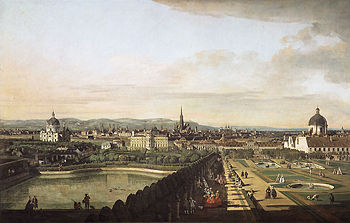
Population
Austria's total population in 2007 was 8,316,487. The population of the capital, Vienna, exceeds 1.6 million (2.2 million with suburbs), representing about a quarter of the country's population and is known for its vast cultural offerings and high standard of living. The median age for the total population was 41.3 years. Austrians had an average life expectancy at birth of 79.21 years (76.32 years for males and 82.26 years for females) in 2007.
Ethnicity
Austrianss make up 91.1 percent of the population, while former Yugoslavs make up four percent (includes Croatians, Slovenes, Serbs, and Bosniaks), Turks 1.6 percent, German 0.9 percent, other or unspecified 2.4 percent, according to the 2001 census. Austrians are a homogeneous people, although four decades of strong immigration have significantly altered the composition of the population of Austria.
German-speaking Austrians, by far the country's largest group, form roughly 90% of Austria's population. The Austrian federal states of Carinthia and Styria are home to a significant (indigenous) Slovenian minority with around 14,000 members. Around 20,000 Hungarians and 30,000 Croatians live in the east-most Bundesland, Burgenland (formerly part of the Hungarian half of Austria-Hungary). The remaining number of Austria's people are of non-Austrian descent, many from surrounding countries, especially from the former East Bloc nations. So-called guest workers (Gastarbeiter) and their descendants, as well as refugees from Yugoslav wars and other conflicts, also form an important minority group in Austria. Since 1994 the Roma and Sinti (gypsies) are an officially recognized ethnic minority in Austria
As of 2006, some of the Austrian states introduced standardised tests for new citizens, to assure their language and cultural knowledge and accordingly their ability to integrate into the Austrian society.
Religion
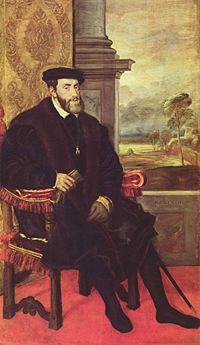
Among religions in Austria, Roman Catholic Christianity is the predominant one, with 73.6 percent of the population counted as adherents, according to the 2001 census. About 12 percent of the population declare that they have no religion. Of the remaining people, about 180,000 are members of Eastern Orthodox Churches and about 7300 are Jewish. The influx of Eastern Europeans, especially from the former Yugoslav nations, Albania and particularly from Turkey largely contributed to a substantial Muslim minority in Austria—around 300,000 are registered as members of various Muslim communities. Buddhism, which was legally recognized as a religion in Austria in 1983, enjoys widespread acceptance and has a following of 20,000 (10,402 at the 2001 census).
Austria was greatly affected by the Protestant reformation, to the point where a majority of the population was eventually Protestant. Due to the prominent position of the Habsburgs in the Counter-Reformation, however, Protestantism was all but wiped out and Catholicism once more restored to the dominant religion. The significant Jewish population (around 200,000 in 1938) in the country, mainly residing in Vienna, was reduced to a mere couple of thousand by the mass emigration in 1938 (more than two thirds of the Jewish population emigrated from 1938 until 1941) and the following Holocaust during the Nazi regime in Austria. Immigration in more recent years, primarily from Turkey and the former Yugoslavia, has led to an increase in the number of Muslims and Serbian Orthodox Christians.<
In the Eurostat - Eurobarometer poll of 2005, 54 percent of Austrian citizens responded that they believe there is a God, whereas 34 percent answered that they believe there is some sort of spirit or life force, and eight percent that they do not believe there is a God, spirit, nor life force.
Language
According to the 2001 census, the mother tongue of the population by prevalence, is German (88.6%) followed by Turkish (2.3%), Serbian (2.2%), Croatian (1.6%), Hungarian (0.5%) and Bosnian (0.4%).
The official language, German, is spoken by almost all residents of the country. Austria's mountainous terrain led to the development of many distinct German dialects. All of the dialects in the country, however, belong to Austro-Bavarian groups of German dialects, with the exception of the dialect spoken in its west-most Bundesland, Vorarlberg, which belongs to the group of Alemannic dialects. There is also a distinct grammatical standard for Austrian German with a few differences to the German spoken in Germany.
Men and women
Most Austrians consider it women's work to do household chores, cook, and care for children. Austrian women work outside the home less frequently than women in other European countries, and women tend to be under-represented in business and the professions. Despite equal-pay, most women are paid less than men for the same type of job. Austrian men, especially among older and rural families, are still considered the head of the family. Men have compulsory military service and work in industry, farming, trades, and professions. Austrian men have a high suicide rate.
Marriage and the family
After a boom in marriages from 1945 through the 1960s, by the late twentieth century, fewer young people marry, more couples divorce, more raise children without marrying. Couples marry later, and educated women choose their career over a family. No-fault divorce has accompanied an increase in marriage break-ups. The domestic unit is the nuclear family of husband, wife, and children, as well as single-parent households, homes of divorced or widowed people, single professionals, and households where a man and woman raise children outside of marriage. Rural households may include extended families. Regarding inheritance of farms, the most common practice is passing the property to one son, while remaining siblings receive cash for their share of the property.
Education
Responsibility for educational oversight in Austria lies partly at the Austrian states (Bundesländer), partly with the federal government. Optional kindergarten education is provided for all children between the ages of three and six years. School attendance is compulsory for nine years, ie usually to the age of fifteen.
Primary education lasts for four years. Alongside Germany, secondary education includes two main types of schools based on a pupil's ability as determined by grades from the primary school: the Gymnasium for the more gifted children which normally leads to the Matura which is a requirement for access to universities and the Hauptschule which prepares pupils for vocational education.
The Austrian university system had been open to any student who passed the Matura examination until recently. A 2006 bill allowed the introduction of entrance exams for studies such as Medicine. Currently all students are charged a fee of about €370 per semester for all university studies. A recent OECD report critizised the Austrian education system for the low number of students attending universities and the overall low number of academics compared to other OECD countries. Regarding literacy, 98 percent of the total population over the age of 15 could read and write in 2003.
Class
In the early 1800s, Austrian society consisted of aristocrats, "citizens," and peasant-farmers or peasant-serfs. At the beginning of the twentieth century, the aristocracy diminished and a small middle class of entrepreneurs, and a larger working class, were added to the existing structure. After World War II, the middle class expanded, so that by the late twentieth century there were more middle-class citizens than any other group. Education was considered the means to upward mobility in 2007. Equality was promoted, although foreign workers, immigrants, and Gypsies were less accepted. An old Austrian family lineage and inherited wealth remain symbols of status in Austrian culture. Wealth is displayed in a second home and more material possessions.
Culture
Template:Austrians
Music
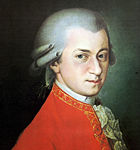
Austria's past as a European power and its cultural environment have generated a broad contribution to various forms of art, most notably among them music. Austria has been the birthplace of many famous composers such as Wolfgang Amadeus Mozart, Joseph Haydn, Franz Schubert, Anton Bruckner, Johann Strauss, Sr., Johann Strauss, Jr. and Gustav Mahler as well as members of the Second Viennese School such as Arnold Schoenberg, Anton Webern and Alban Berg.
Vienna has long been especially an important center of musical innovation. Eighteenth and nineteenth century composers were drawn to the city due to the patronage of the Habsburgs, and made Vienna the European capital of classical music. During the Baroque period, Slavic and Hungarian folk forms influenced Austrian music. Vienna's status began its rise as a cultural center in the early 1500s, and was focused around instruments including the lute. Ludwig van Beethoven spent the better part of his life in Vienna.
Austria's current national anthem was chosen after World War II to replace the traditional Austrian anthem by Joseph Haydn. The composition, which was initially attributed to Mozart, was most likely not composed by Mozart himself.
Austria has also produced one notable jazz musician, keyboardist Josef Zawinul who helped pioneer electronic influences in jazz as well as being a notable composer in his own right.
Art and architecture

Among Austrian artists and architects one can find painters Gustav Klimt, Oskar Kokoschka, Egon Schiele or Friedensreich Hundertwasser, photographer Inge Morath or architect Otto Wagner.
Science, philosophy and economics
- See also: Austrian School and List of Austrian scientists
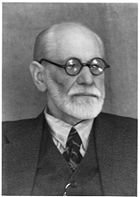
Austria was the cradle of numerous scientists with international reputations. Among them are Ludwig Boltzmann, Ernst Mach, Victor Franz Hess and Christian Doppler, prominent scientists in the nineteenth century. In the twentieth century, contributions by Lise Meitner, Erwin Schrödinger and Wolfgang Pauli to nuclear research and quantum mechanics were key to these areas' development during the 1920s and 1930s. A present-day quantum physicist is Anton Zeilinger, noted as the first scientist to demonstrate quantum teleportation.
In addition to physicists, Austria was the birthplace of two of the greatest philosophers of the twentieth century, Ludwig Wittgenstein and Karl Popper. In addition to them biologists Gregor Mendel and Konrad Lorenz as well as mathematician Kurt Gödel and engineers such as Ferdinand Porsche and Siegfried Marcus were Austrians.
A focus of Austrian science has always been medicine and psychology, starting in medieval times with Paracelsus. Eminent physicians like Theodore Billroth, Clemens von Pirquet, and Anton von Eiselsberg have built upon the achievements of the 19th century Vienna School of Medicine. Austria was home to psychologists Sigmund Freud, Alfred Adler, Paul Watzlawick and Hans Asperger and psychiatrist Viktor Frankl.
The Austrian School of Economics, which is prominent as one of the main competitive directions for economic theory is related to Austrian economists Joseph Schumpeter, Eugen von Böhm-Bawerk, Ludwig von Mises, and Friedrich Hayek.
Other noteworthy Austrian-born émigrés include the management thinker Peter Drucker and the 38th Governor of California, Arnold Schwarzenegger.
Literature
Complementing its status as a land of artists and scientists, Austria has always been a country of poets, writers,and novelists. It was the home of novelists Arthur Schnitzler, Stefan Zweig, Thomas Bernhard, Franz Kafka or Robert Musil, of poets Georg Trakl, Franz Werfel, Franz Grillparzer, Rainer Maria Rilke or Adalbert Stifter and writer Karl Kraus.
Famous contemporary playwrights and novelists are Nobel prize winner Elfriede Jelinek and writer Peter Handke.
Cuisine
Austria's cuisine is derived from the cuisine of the Austro-Hungarian Empire. In addition to native regional traditions, it has been influenced above all by Hungarian, Czech, Jewish, Italian and Bavarian cuisines, from which both dishes and methods of food preparation have often been borrowed. The Austrian Cuisine is therefore one of the most multi and transcultural cuisines in Europe.
Typical Austrian dishes include Wiener Schnitzel, Schweinsbraten, Kaiserschmarren, Knödel, Sachertorte and Tafelspitz. There are also Kasnockn, a macaroni dish with fresh Pinzgauer cheese and parsley, and Eierschwammerl dishes. The Eierschwammerl are the native yellow, tan mushrooms. These mushrooms are delicious, especially when in a thick Austrian soup, or on regular meals.
The candy PEZ was invented in Austria. Austria is also famous for its' Apfelstrudel.
Sports
The most popular sport in Austria is alpine skiing and Austria shows constant dominance in the Nations-Cup. Similar sports such as snowboarding or ski-jumping are also widely popular. The most popular team sport in Austria is football. However, Austria rarely has international success in this discipline, though the 2008 UEFA European Football Championship is jointly being held with Switzerland. Besides football, Austria also has professional national leagues for most major team sports including ice hockey, and basketball.
See also
|
|
|
ReferencesISBN links support NWE through referral fees
External links
- Austria World Fact Book 2007, accessed November 25, 2007.
- Culture of Austria Countries and Their Cultures, accessed November 25, 2007.
- Travel tips Austria
- Connections Europe to Austria
- The aeiou Encyclopedia (Homepage | Table of Contents | Search)
- Austrians Yesterday and Today
- Austria.info Official homepage of the Austrian National Tourist Office
- History of Austria: Primary Documents
- Federal Chancellery of Austria
- Austrian Law Information on Austrian Law
- CIA World Factbook entry on Austria
- Library of Congress Portals on the World - Austria
- US Department of State Facts and Information [updated February 2005]
- Austria News News from Austria in English language
- Entry Requirements to Austria
- Culture and History of Austria
- Photos
{{Template group
|title =  Geographic locale
Geographic locale
Credits
New World Encyclopedia writers and editors rewrote and completed the Wikipedia article in accordance with New World Encyclopedia standards. This article abides by terms of the Creative Commons CC-by-sa 3.0 License (CC-by-sa), which may be used and disseminated with proper attribution. Credit is due under the terms of this license that can reference both the New World Encyclopedia contributors and the selfless volunteer contributors of the Wikimedia Foundation. To cite this article click here for a list of acceptable citing formats.The history of earlier contributions by wikipedians is accessible to researchers here:
- Austria history
- Geography_of_Austria history
- Economy_of_Austria history
- Demographics_of_Austria history
- Religion_in_Austria history
The history of this article since it was imported to New World Encyclopedia:
Note: Some restrictions may apply to use of individual images which are separately licensed.


